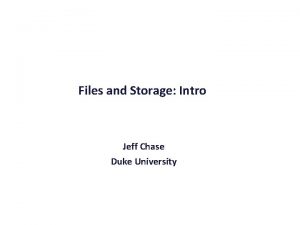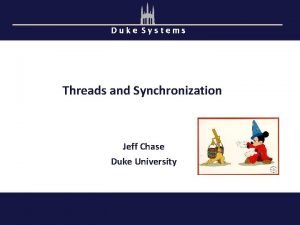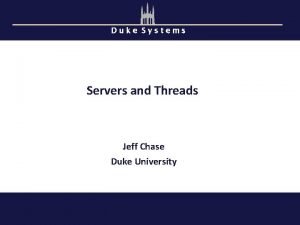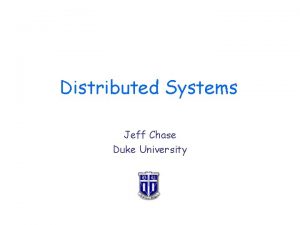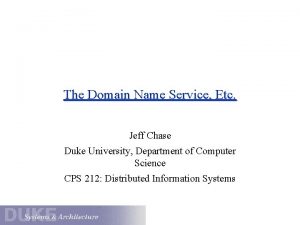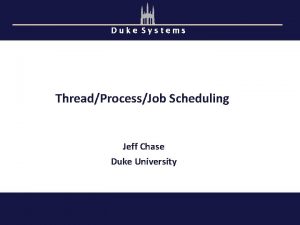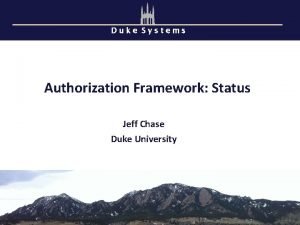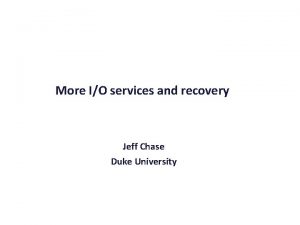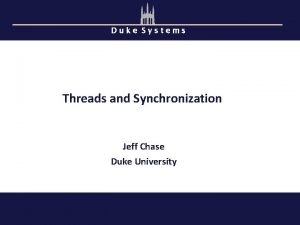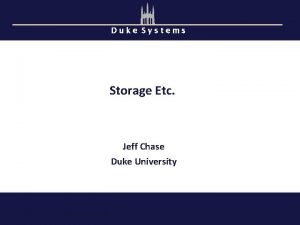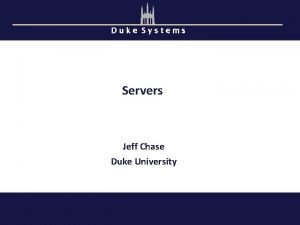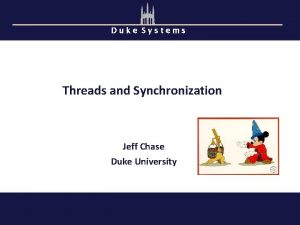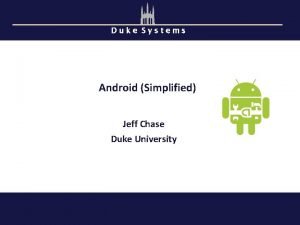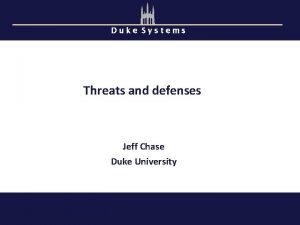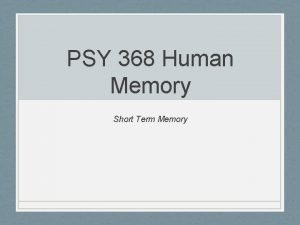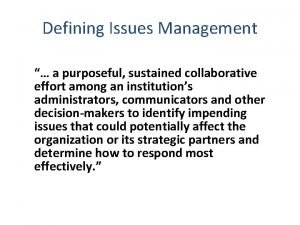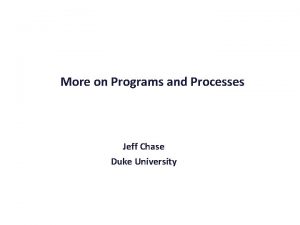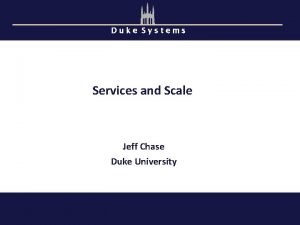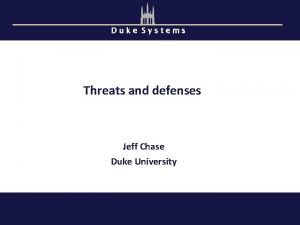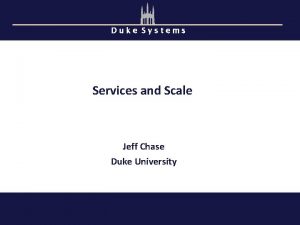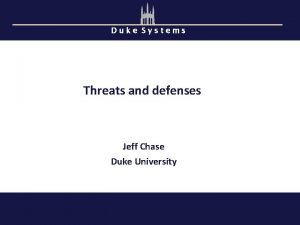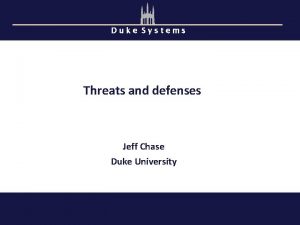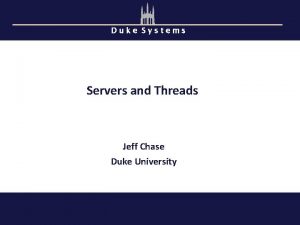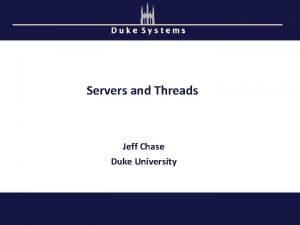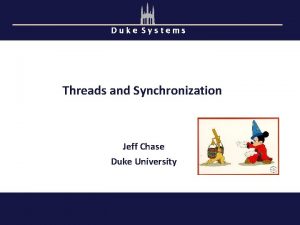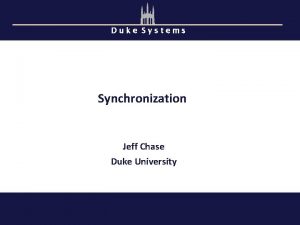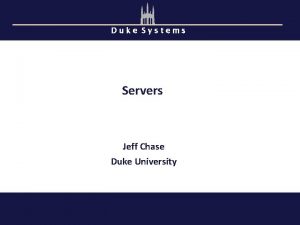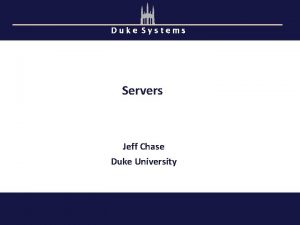More on Programs and Processes Jeff Chase Duke














![Alignment p + 0 x 0 X char p[] char *p int p[] int* Alignment p + 0 x 0 X char p[] char *p int p[] int*](https://slidetodoc.com/presentation_image_h2/e567594c63c98dace28c5ebc231c603c/image-15.jpg)












![cpu. c (OSTEP) int main(int argc, char *argv[]) { if (argc != 2) { cpu. c (OSTEP) int main(int argc, char *argv[]) { if (argc != 2) {](https://slidetodoc.com/presentation_image_h2/e567594c63c98dace28c5ebc231c603c/image-28.jpg)

![mem. c (OSTEP) data p int main(int argc, char *argv[]) { int *p; p mem. c (OSTEP) data p int main(int argc, char *argv[]) { int *p; p](https://slidetodoc.com/presentation_image_h2/e567594c63c98dace28c5ebc231c603c/image-30.jpg)

- Slides: 31

More on Programs and Processes Jeff Chase Duke University

OS Platform Applications Libraries: shared by multiple applications Kernel: same for all applications OS platform mediates access to shared resources. [RAD Lab]

A simple module int val = 0; int p 1(char *s) { return 1; } int p 2() { char *s; int i; s = "hellon"; i = p 1(s); return(i); } state P 1() API P 2() P 3() P 4() E. g. , a library

Calling the module #include <stdio. h> extern int p 1(); interface extern int p 2(); signatures int main() { int i; state P 1() P 2() P 3() P 4() Program i = p 2(); printf("%dn", i); }

The Birth of a Program (C/Ux) myprogram. c int j; char* s = “hellon”; myprogram. o assembler data object file int p() { j = write(1, s, 6); return(j); } data p: compiler …. . store this store that push jsr _write ret etc. myprogram. s header files libraries and other object files or archives linker data program myprogram (executable file)

Running a program code constants initialized data imports/exports symbols types/interfaces Process data Program When a program launches, the OS creates an execution context (process) to run it, with a thread to run the program, and a virtual memory to store the running program’s code and data.

VAS example (32 -bit) • The program uses virtual memory through its process’ Virtual Address Space: 0 x 7 fffffff Reserved Stack • An addressable array of bytes… • Containing every instruction the process thread can execute… • And every piece of data those instructions can read/write… – i. e. , read/write == load/store on memory Dynamic data (heap/BSS) • Partitioned into logical segments with distinct purpose and use. Static data • Every memory reference by a thread is interpreted in the context of its VAS. Text (code) – Resolves to a location in machine memory 0 x 0

Heap: dynamic memory A contiguous chunk of virtual memory obtained from OS kernel. E. g. , with Unix sbrk() system call. A runtime library obtains the block and manages it as a “heap” for use by the programming language environment, to store dynamic objects. E. g. , with Unix malloc and free library calls. Allocated heap blocks for structs or objects. Align! Free block

Get started on heap manager! • To get started on heap manager, download the files and type “make”. – Provides a script to build the heap manager test programs on Linux or Mac. OS. • This lab is just a taste of system programming in C. • The classic text is CS: APP. • Also see PDF “What every computer systems student should know about computers” on the course website. • You may think of it as notes from CS: APP. It covers background from Computer Architecture and also some material for this class. http: //csapp. cs. cmu. edu a classic

Basic hints on using Unix • Find a properly installed Unix system: linux. cs. duke. edu, or Mac. OS with Xcode and its command line tools will do nicely. • Learn a little about the Unix shell command language: e. g. , look ahead to the shell lab, Lab #2. On Mac. OS open the standard Terminal utility. • Learn some basic commands: cd, ls, cat, grep, more/less, pwd, rm, cp, mv, and a text editor of some kind (vi, emacs, …). Spend one hour. • Learn basics of make. Look at the makefile. Run “make –i” to get it to tell you what it is doing. Understand what it is doing. • Wikipedia is a good source for basics. Use the man command to learn about commands (1), syscalls (2), or C libraries (3). E. g. : type “man man”. • Know how to run your programs under a debugger: gdb. If it crashes you can find out where. It’s easy to set breakpoints, print variables, etc. • If your program doesn’t compile, deal with errors from the top down. Try “make >out 2>out”. It puts all output in the file “out” to examine at leisure. • Put source in a revision system like git or svn, but Do. Not. Share. It.

Using the heap (1) #include <stdlib. h> #include <stdio. h> int main() { char* cb = (char*) malloc(14); cb[0]='h'; cb[1]='i'; chase$ cc -o heap. c cb[2]='!'; chase$. /heap cb[3]='�'; hi! printf("%sn", cb); chase$ free(cb); }

Using the heap (2) #include <stdlib. h> #include <stdio. h> cb ip h=0 x 68 i=0 x 69 !=0 x 21 0 int main() { char* cb = (char*) malloc(14); cb[0]='h'; chase$ cc -o heap cb[1]='i'; cb[2]='!'; chase$. /heap cb[3]='�'; hi! printf("%sn", cb); 0 x 216968 int *ip = (int*)cb; chase$ printf("0 x%xn", *ip); free(cb); Try: } http: //wikipedia. org/wiki/ASCII heap. c http: //wikipedia. org/wiki/Endianness

Endianness Lilliput and Blefuscu are at war over which end of a soft-boiled egg to crack. Gulliver’s Travel’s 1726 A silly difference among machine architectures creates a need for byte swapping when unlike machines exchange data over a network.

64 bytes: 3 ways p + 0 x 0 Memory is “fungible”. 0 x 0 int p[] int* p char p[] char *p 0 x 1 f p 0 x 0 char* p[] char** p 0 x 1 f Pointers (addresses) are 8 bytes on a 64 -bit machine. 0 x 1 f
![Alignment p 0 x 0 X char p char p int p int Alignment p + 0 x 0 X char p[] char *p int p[] int*](https://slidetodoc.com/presentation_image_h2/e567594c63c98dace28c5ebc231c603c/image-15.jpg)
Alignment p + 0 x 0 X char p[] char *p int p[] int* p X 0 x 1 f p char* p[] char** p 0 x 0 X 0 x 1 f Machines desire/require that an n-byte type is aligned on an n-byte boundary. n = 2 i 0 x 1 f

Using the heap (3) char* cb = (char*)malloc(14); strcpy(cb, "hi!"); free(cb); /* * Dangling reference! */ printf("%sn", cb); int *ip = (int*)cb; printf("0 x%xn", *ip); /* * Uninitialized heap block! */ char* cb 2 = (char*)malloc(14); printf("%sn", cb 2); cb ip h=0 x 68 i=0 x 69 !=0 x 21 0 chase$ cc -o heap 2. c chase$. /heap 2 ? ? ? chase$

Using the heap (4) char* cb = (char*)malloc(14); strcpy(cb, "hi!"); free(cb); /* * Dangling reference! */ printf("%sn", cb); int *ip = (int*)cb; printf("0 x%xn", *ip); /* * Uninitialized heap block! */ char* cb 2 = (char*)malloc(14); printf("%sn", cb 2); cb ip h=0 x 68 i=0 x 69 !=0 x 21 0 chase$ cc -o heap 2. c chase$. /heap 2 hi! 0 x 216968 hi! chase$

WARNING • These behaviors are undefined. • Any program whose behavior relies on the meaning of a dangling reference is incorrect. • For example, a change in the allocation policy of the heap manager could result in different behavior. • Can a program stay safe from dangling references by just never calling free?

Another way • Java’s new operator calls malloc “under the hood”. – Allocate a heap block for each new object. – How big should the heap block be? Who decides? – Java initializes the block by automatically calling a type-specific constructor defined by the program. – C++ is the same. • But in Java there is no free (or delete)! – No dangling references! • How does Java avoid memory leaks?

Digression: Garbage collection • Java has new but no free (or delete)! – No dangling references! • Q: How does Java avoid memory leaks? • A: automatic garbage collection • Java is strongly typed: e. g. , it tracks and controls pointers, and it knows where all of them are and what object types they reference. • Java knows if an object has no references pointing to it, and it calls free for you! • But Java has no pointer arithmetic: your program cannot manipulate virtual addresses as numbers, as in C.

Pointer arithmetic char* cb = (char*) malloc(14); strcpy(cb, "hi!"); cb ptr h=0 x 68 i=0 x 69 !=0 x 21 0 unsigned long ptr = (unsigned long)cb; ptr = ptr + 2; cb = (char*)ptr; printf("%sn", cb); free(cb); chase$ cc -o heap 3. c chase$. /heap 3 ? ? ? chase$

Pointer arithmetic char* cb = (char*) malloc(14); strcpy(cb, "hi!"); cb ptr unsigned long ptr = (unsigned long)cb; ptr = ptr + 2; cb = (char*)ptr; printf("%sn", cb); free(cb); h=0 x 68 i=0 x 69 !=0 x 21 0 chase$ cc -o heap 3. c chase$. /heap 3 ! heap 3(5478) malloc: *** error for object 0 x 7 f 92 a 9 c 000 e 2: pointer being freed was not allocated Abort trap: 6 chase$

About the heap manager • The heap manager is a library module. A program can redefine it, change it, misuse it. • It manages memory only within a running program. The kernel allocates memory among programs (processes) – E. g. , via sbrk or mmap system calls. The heap manager does not protect the program from itself! A buggy program can corrupt the heap! A buggy heap manager can crash the program! “fate sharing” processes prog lib OS kernel

Heap manager policy • The heap manager must find a suitable free block to return for each call to malloc(). – No byte can be part of two simultaneously allocated heap blocks! If any byte of memory is doubly allocated, programs will fail. We test for this! • A heap manager has a policy algorithm to identify a suitable free block within the heap. – Last fit, first fit, best fit, worst fit – Choose your favorite! – Goals: be quick, and use memory efficiently – Behavior depends on workload: pattern of malloc/free requests • This is an old problem in computer science, and it occurs in many settings: variable partitioning.

Variable Partitioning Variable partitioning is the strategy of parking differently sized cars along a street with no marked parking space dividers. 1 2 3 Wasted space external fragmentation

Fixed Partitioning Wasted space internal fragmentation

0 x 7 fffffff Reserved Stack Dynamic data (heap/BSS) Static data Text (code) 0 x 0
![cpu c OSTEP int mainint argc char argv if argc 2 cpu. c (OSTEP) int main(int argc, char *argv[]) { if (argc != 2) {](https://slidetodoc.com/presentation_image_h2/e567594c63c98dace28c5ebc231c603c/image-28.jpg)
cpu. c (OSTEP) int main(int argc, char *argv[]) { if (argc != 2) { fprintf(stderr, "usage: cpu <string>n"); exit(1); } char *str = argv[1]; while (1) { printf("%sn", str); Spin(1); } return 0; } time chase$ cc -o cpu. c chase$. /cpu A & chase$. /cpu B & A A B B B A B …

Foreground and background • A multiprogrammed OS can run many processes concurrently / simultaneously / at the same time. • When you run a program as a command to the shell (e. g. , Terminal), by default the process is foreground. – T he shell calls the OS to create a child process to run the program, passes control of the terminal to the child process, and waits for the process to finish (exit). • You can also run a program in background with &. – & is an arbitrary syntax used in Unix since the 1960 s. – The shell creates the child process and starts it running, but keeps control of the terminal to accept another command. – & allows you to run multiple concurrent processes. – The processes share the machine; they could run different programs, or the same program.
![mem c OSTEP data p int mainint argc char argv int p p mem. c (OSTEP) data p int main(int argc, char *argv[]) { int *p; p](https://slidetodoc.com/presentation_image_h2/e567594c63c98dace28c5ebc231c603c/image-30.jpg)
mem. c (OSTEP) data p int main(int argc, char *argv[]) { int *p; p = malloc(sizeof(int)); *p = atoi(argv[1]); while (1) { Spin(1); *p = *p + 1; printf("(pid: %d) value of p: %dn”, getpid(), *p); } } pid: 5587 pid: 5588 chase$ cc -o mem. c chase$. /mem 21 & chase$. /mem 42 & (pid: 5587) value of p: 22 (pid: 5587) value of p: 23 (pid: 5587) value of p: 24 (pid: 5588) value of p: 43 (pid: 5588) value of p: 44 (pid: 5587) value of p: 25 (pid: 5587) value of p: 26 …

Operating Systems: The Classical View Programs run as independent processes. data Protected system calls Protected OS kernel mediates access to shared resources. Each process has a private virtual address space and one or more threads. . and upcalls (e. g. , signals) Threads enter the kernel for OS services. The kernel code and data are protected from untrusted processes.
 Lirik lagu more more more we praise you
Lirik lagu more more more we praise you More more more i want more more more more we praise you
More more more i want more more more more we praise you Jeff chase duke
Jeff chase duke Jeff chase duke
Jeff chase duke Jeff chase duke
Jeff chase duke Chase distributed system
Chase distributed system Jeff chase duke
Jeff chase duke Jeff chase duke
Jeff chase duke Jeff chase duke
Jeff chase duke Jeff chase duke
Jeff chase duke Jeff chase duke
Jeff chase duke Jeff chase duke
Jeff chase duke Jeff chase duke
Jeff chase duke Jeff chase duke
Jeff chase duke Jeff chase duke
Jeff chase duke Jeff chase duke
Jeff chase duke Jeffrey chase duke
Jeffrey chase duke Disadvantages of waterfall model in software engineering
Disadvantages of waterfall model in software engineering Concurrent processes are processes that
Concurrent processes are processes that Human history becomes more and more a race
Human history becomes more and more a race The more you take the more you leave behind
The more you take the more you leave behind The more you study the more you learn
The more you study the more you learn Aspire not to
Aspire not to Newton's 1 law
Newton's 1 law Knowing more remembering more
Knowing more remembering more More love to thee o lord
More love to thee o lord More choices more chances
More choices more chances How do huck and jim dress on the raft
How do huck and jim dress on the raft Chase and simon 1973
Chase and simon 1973 Chase demand strategy formula
Chase demand strategy formula R형 s형
R형 s형 Jones and chase issues management model
Jones and chase issues management model


